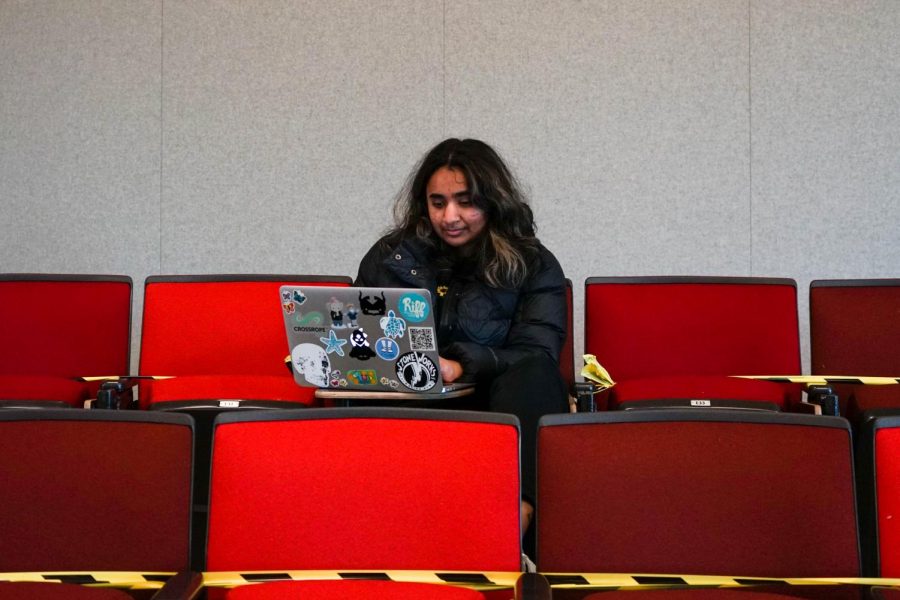Bridges: ‘A new kind of learning’: the need for hybrid classrooms
April 12, 2021
Remote learning has its benefits for students; it gives them the freedom to take classes anywhere and attend even if they have other important responsibilities.
This past year of online learning throughout the COVID-19 pandemic has reminded us that we must change the way we learn and teach to accommodate all students.
A student who is a parent should not have to decide between attending their lectures and attending to their child; a caretaker should not have to leave those they care for to gain an education; international students unable to leave their home countries should still be able to find themselves in live classes; those unable to afford living expenses in Corvallis, Ore. near the Oregon State University campus should still be able to be in the classroom; and students in crisis should be cared for, not forgotten.
As the OSU College of Education Dean Dr. Susan Gardner said, “life doesn’t always happen in these neat 50 minute compartments.” Gardner explained that “from the synchronous perspective it’s been helpful that we have been able to see that there are lots of ways that students can participate.”
Gardner said she has come to see that perhaps even how we rigidly saw things like deadlines are sometimes arbitrary.
Above all, this year has shown the importance of creating a “a culture of care,” as Associate Dean Susan Rodgers of the OSU Honors College put it. Mental health struggles, illness, and burnout are not new issues—and they are not going away when we return to the physical classroom.
A culture of care actively seeks out feedback about the well-being of students and provides tools to make up work and learn material missed due to difficult circumstances.
Students should not be afraid to ask for extensions, clarifications or accommodations, and mental health resources should be regularly presented to students.
The limitations of remote learning have also created immense stress, disconnection and isolation for students. We’ve all been in that breakout room—black screens and total silence until that little timer pops up and closes it.
Students including myself have realized what we appreciated about in person learning; brisk walks to class, grabbing a coffee to survive your lecture, small talk with classroom acquaintances, and above all the feeling that we really are students, sitting in a classroom and working hard to build a future for ourselves—not just sitting behind a computer screen in our pajamas with fifteen tabs open and our Zoom cameras off.
Remote learning also poses difficulties for students with limited internet access. Gardner calls this the “digital divide” still present in our communities that forces some to seek out public internet access, and share internet and devices among family and friends, limiting their ability to attend class.
College instructors have also struggled with remote learning. They often face what Dr. Regan A. R. Gurung, interim executive director of the Center for Learning and Teaching, calls a “sea of black screens,” unable to gauge students’ reactions to content.
The CLT has been important for faculty and students throughout this past year. Simply put, the CLT provides support for instructors in all their endeavors.
The CLT meets directly with staff and provides online resources and a number of workshops; the front webpage is full of infographics about remote teaching, best Zoom practices, motivation strategies and many other relevant resources for this upcoming remote spring term.
Gurung explained they have seen an increase in the number of faculty seeking out their resources during the shift to remote learning. He also discussed how tools such as the Zoom chat function have given students opportunities to engage unlike before.
“[If] you’re sitting in row 42 of LINC 128, how can your voice be heard?” Gurung asked. Moving forward, we need to utilize technology to help give all students a chance to speak out in classes and use their voice. He concluded that “really what we want is to afford you the ability to join a conversation.”
Providing multiple ways for students to engage in the classroom will allow different types of learners to all excel; students can still raise their hand and engage physically, while other students who are less comfortable speaking in front of their peers or instructors can use other engagement systems.
This moment highlights the need for research-based teaching methods and for keeping up with technological advancements in the classroom.
Small talk and uncomfortable desks are not reason enough to force students to attend live lectures once it is safe to do so, and professors need to honestly question the ways they engage with students and create an environment of productive conversation and collaboration. At the CLT, Gurung tells professors to “always ask yourself what makes a synchronous or live experience worth it?”
Students may also have mixed reactions to pre-recorded lectures. Sometimes being able to watch lectures at your convenience is wonderful, and other times the hour and fifty minute lectures seem inconvenient.
Gurung agrees that recorded lectures have their benefits, but need to be properly executed; “no student should need to listen to a fifty minute, let alone one hour fifty minute recording. That’s crazy.”
We need to hybridize the classroom, and create that culture of care that supports all students regardless of their circumstances. Students should have the option to engage with content virtually if they need to, and we should constantly be investing in new technology that allows students to do so—and never at the expense of the student.
As Gurung explains, “face to face is a huge part of college” but we need to “make sure it is done well.”











































































































